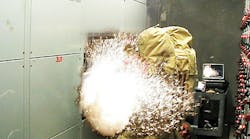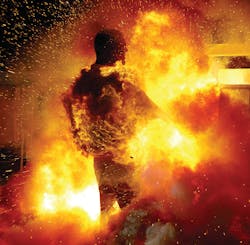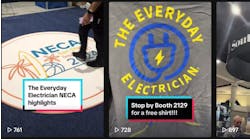When it comes to arc flash incidents, the two biggest safety threats to electrical professionals are complacency and overconfidence. That was the message Scott Francis, technical sales manager for Westex by Milliken, conveyed in his NECA Live presentation, “Arc Flash Safety: Building Organizational Resilience and Best PPE Practices,” on October 8. From using uncomfortable flame resistant (FR)/ arc-rated (AR) garments that turn daily wear clothing programs into task-based clothing programs to taking shortcuts and failing to wear the appropriate PPE, Francis detailed how a number of comfort and error precursor obstacles can jeopardize organizational safety.
Kicking off the virtual session with an overview of the hierarchy of risk control methods in NFPA 70E Sec.119.1(H), Francis emphasized that the risk assessment procedure requires that preventive and protective risk control methods must be implemented in accordance with the following hierarchy:
- Elimination,
- Substitution,
- Engineering Controls,
- Awareness,
- Administrative Controls, and
- PPE.
“Out of all of these controls, no control is infallible,” he said. “All risk controls are subject to errors in human performance.”
That was the big change in the 2018 70E — that human error must be accounted for in the risk assessment procedure, noted Francis, confirming that this would stay the same in the 2021 edition, which will be coming out shortly. According to Sec. 110.1 (H), “the risk assessment procedure shall address the potential for human error and its negative consequences on people, processes, the work environment, and equipment.” As stated in the corresponding informational note (Annex Q), “the potential for human error varies with factors such as tasks and the work environment.” Although Francis explained Annex Q is for informational purposes only — meaning you don’t have to utilize it to be compliant with NFPA 70E — he advised attendees to take advantage of the excellent information it has to offer on how to counter human error with human performance tools and human performance awareness.
According to Francis, more than 90% of the incidents in the industry are caused by human error while less than 10% are caused by other hazardous conditions. That’s why implementing change to improve a safety culture can begin with just a few key workers. Even the best people make mistakes, maintains Francis, noting that the best way to achieve buy-in to an FR/AR PPE program is by engaging field leaders. “You really need to develop and train the workforce, especially the key influential field leaders on human performance and PPE best practices,” he said. “These influential worker leaders will spread the appropriate human performance tools and PPE best practices to the rank and file workers that will surely improve the overall organizational safety culture.”
Turning the discussion to Table Q.5 from Informational Annex Q, Francis spent some time discussing error precursors, which are situations when the demands of the task environment exceed the capabilities of the worker or the limitations of human nature. These unfavorable conditions increase the probability for error during a specific work task, such as task demands, work environment, individual capabilities and human nature. “This table is an excellent tool — a worksheet if you will — that basically helps match human performance tools, which are on the right hand side of the table, that are used to counter the error precursors [on the left] that your organization may be experiencing,” he said.
Francis proceeded to highlight the two main types of AR/FR clothing: task-based, in which proper AR/FR clothing is put on to perform a specific task, and daily wear, in which proper AR/FR clothing is worn at all times during work hours. According to Francis, there is a significantly larger risk with task-based PPE due to the possibility of human error. When you’re dealing with potential arc flash blasts, the chance of exposing flammable clothing to thermal hazards that can result in significant burn injuries or even death is always looming in the shadows. He explained why low-energy tasks are more susceptible to complacency. Electrical workers may be less likely to don the appropriate PPE at the appropriate time for Cat. 1 and Cat. 2 type tasks, for example, because they’re considered low voltage. “That’s not a big issues with Cat. 3 or 4 tasks because that’s high energy — that’s already got the worker’s attention and they’re going to go get the proper PPE,” he said. “The problem is complacency with the low-energy tasks that are routine.”
What often happens, explains Francis, is younger employees see older, more experienced workers in an organization not wearing the PPE for all low-energy tasks; therefore, they develop what he calls a “normalization of deviance,” which is the gradual process through which unacceptable practices and standards become acceptable. “As the deviant behavior is repeated without catastrophic results, it becomes the social norm of the organization — and that’s not good, he said. “Complacency is usually the root cause of these incidents at 480V. Even though that’s considered low voltage, it’s the leading killer in the electrical industry.”
The main goal is to reduce the likelihood of incident occurrence and to mitigate the severity of burn injury from arc flash hazards. According to Francis, the daily wear programs, with innovations in fabric and garment technology, now provide a comfortable “want-to-wear” best-practice program that further reduces the burn risk injury and increases an organization’s safety culture. “When you think about a safety culture, it’s the little things,” he said. “It’s getting those worker leaders involved and making them cognizant of these human error precursors and how to counter them with human error performance skills and best-practice PPE so that it’s going to be infectious to the rest of the crew.”





